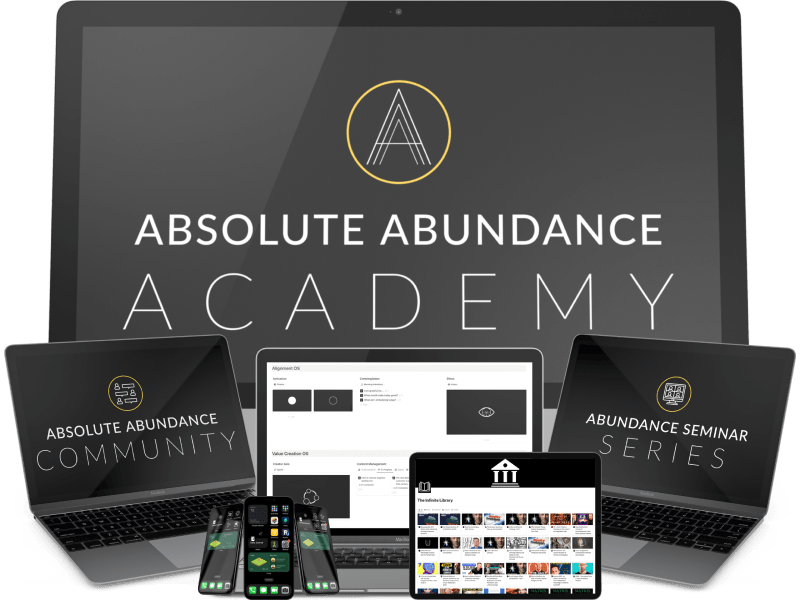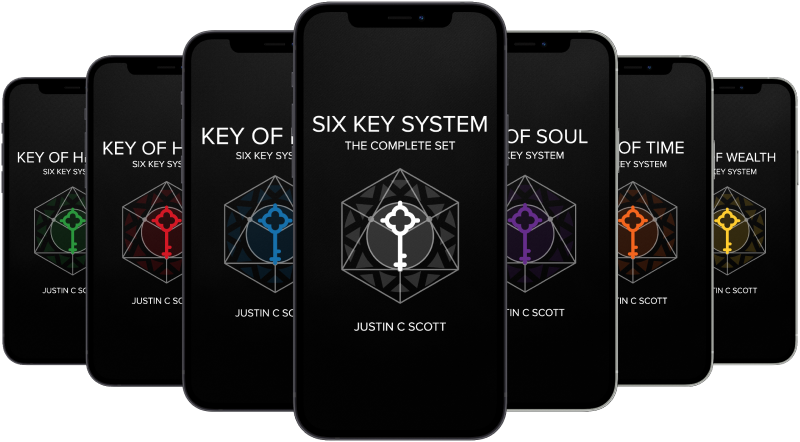Today you’ll learn:
- How to maximize the creative potential an idea can give you
- How to maximize the level of impact you can get out of an idea
- How to maximize the level of distribution you can get out of an idea
Before we get started…
- Join the Absolute Abundance Academy waitlist, an 8-12 week program for content creators, consultants, and infopreneurs ready to go from overwhelmed and underpaid to deeply fulfilled and richly rewarded.
- Learn more about how to master creativity, money, and freedom inside of the Key of Wealth
There are people who create content so consistently that it seems like it must be all they do.
And in a sense, it is.
When you’re a content creator, everything has the potential to feed your content ecosystem (I once wrote 25 tweets from 3 chapters of a manga I was reading without even really having to try, and you would never have known by reading the tweets).
Wouldn’t it be nice if you could do the same?
To be one of those people who makes it look easy?
To be one of those creators who never seems to run out of ideas, concepts, or creativity?
After all, you want to build a successful content-based brand + biz, but you’re intimidated by the reality of what it takes.
And who can blame you – this is hard work and requires commitment.
But if you approach it with the right perception, and develop an effective system, it doesn’t have to be so intimidating – and the work doesn’t have to be quite as hard.
In fact, it can be a lot of fun (and much easier than you likely think possible).
In the previous article, I presented the concept of the fractal-based content system:

A fractal is a system that infinitely replicates itself in patterns.
Think of a tree – a branch is a small version of a bough, and a bough is a small version of a trunk.
The entire structure is a pattern that repeats itself.
Your content ecosystem should (eventually) function the same way:
- Longform content that goes in-depth (trunk) – newsletter, blog post, YouTube video
- Midform content that highlights the key points (bough) – twitter thread, instagram carousel, linkedin post
- Shortform content that highlights a single key point (branch) – tweets, IG stories, micro-videos
This system of content creation is designed to achieve 3 core outcomes with as little time/energy spent as possible:
- Maximizing the creative potential an idea can give you
- Maximizing the level of impact you can get out of an idea
- Maximizing the level of distribution you can get out of an idea
Today, I’m going to give you a nothing-held-back look into how to do each one.
You will never think of idea generation or content creation the same way again.
Maximizing creative potential
First, we start with the foundation for the system – the longform piece of content (trunk) that goes as in-depth as possible with your idea.
Your longform newsletter, blog post, and/or YouTube video.
This is where you’re going to spend the majority of your attention, time, and energy within the system.
The key to operating in this stage effectively is research and synthesis.
Once you’ve decided on an idea, you want 3-5 primary resources in the form of videos, articles/newsletters, books, and podcasts that cover the idea thoroughly and can provide you with insight, context, and undiscovered intersections of information.
One of the biggest snags here is where you put your focus when fleshing the idea out – don’t think the idea needs to be entirely original to be valuable.
Instead, focus on making the presentation and intersections of the information unique.
For example, take this article – at its core, it’s an article about content creation and how to create content effectively.
That is not an original idea, there’s been plenty of content created about how to effectively create content.
What’s unique, however, is the presentation and intersections of the idea.
The fractal-based content system is probably something you’ve never heard of before (presentation) and the ways in which the intersections (creativity, impact, distribution) are applied are probably ways you never thought of before.
Ultimately, originality is not something to get hung up on – trust yourself as the messenger to present the message in an inherently unique way, even if what’s being presented has been presented by another messenger.
Focus on making your content useful, applicable, and (most importantly) interesting to you and your audience.
Next, you want to prioritize a creation system that supports both your ability to go deep with the idea and your speed of execution, while diminishing the natural compulsion to want to edit and perfect your presentation of the idea while outlining it.
This is something I used to struggle with – it would take me forever to write a newsletter or article because I wasn’t drafting correctly.
I would try to write from paragraph to paragraph, section to section, instead of outlining the core pieces of information those paragraphs and sections would be built on top of.
The first step to overcoming this is to define your story structure.
Before you sit down to work on your in-depth piece of content, ask yourself each of the following questions:
- Who is the character?
- What do they want or need?
- Why can’t they get what they want or need?
- What happens if they can’t get what they want or need?
- Who or what helps them?
- How do they get what they want or need?
- How does getting what they want or need transform them or their life?
Once you’ve defined your story structure, break down your section set-up.
This is the formula you’ll use for every longform in-depth piece of content you create.
Mine looks like this:
- Introduction – Focus on presenting the big problem, what it’s taking from them, and why they should care
- Body – Focus on presenting the transformation that occurs by solving the problem, benefits gained by making the transformation, and how/what they need to do to solve it
- Close – Focus on tying up loose threads/ends, making final connections between ideas, and ending with value that makes them better than they were before having consumed your work (and, if applicable, provide a call to action / next steps for them to take)
From here, consider your content architecture.
You don’t need to include every one of these elements, but each one can give you a valuable foothold when you (inevitably) find yourself stuck:
- Telling a story – personal, anecdotal, and parable
- Proving a concept – personal theories, information intersections, and shifting paradigms/perceptions
- Telling them why – reasons, examples, data, observations, and comparisons
- Teaching them how – tips, tools, hacks, resources, and frameworks
- Showing them who – identity, fears/obstacles, lessons, abilities, and a brighter future
I’m holding nothing back here, you can clearly see all of these themes and principles woven in and through all of my longform work – including this article.
Finally, and arguably the most impactful concept, is also the simplest…
When you’re drafting/outlining, do it in bullets and lists instead of in sentences, paragraphs, and sections.
I’m not sure why this works so well – I think it’s a psychological trick that makes you feel like you don’t have to immediately connect all of the information at once.
But by bulletting all of the information I want to include in my introduction, body, and close, I’m able to write the entirety of the piece much faster.
Maximizing impact
This is when the fractal-based content system begins to really take shape.
Once you’ve fleshed out the foundation for your idea (trunk) you can begin to construct the first patterns in the fractal (boughs).
Think Twitter threads, LinkedIn posts, and instagram carousels.
This is where you make the most impact with an idea, because it’s the intersection of depth and width.
The longform piece of content is meant for depth and to create impact on an individual level, while the midform piece of content won’t go quite as deep but will create a greater impact on a collective level.
When you’re breaking down the trunk into boughs, you want to understand that these are pieces of content that don’t accommodate the totality of the idea, but zero-in on its key points, lessons, and value propositions.
Longform pieces of content allow for nuance, story, and exploration of concepts.
Midform pieces of content need to be direct, actionable, and to the point.
The approach here is to convert the essence of your longform into 1-3 midform posts that lend themselves to lists, lessons, and how-to’s.
You can usually get 2-3 threads, carousels, or linkedin posts out of a single longform piece of content – sometimes you only get one, but most of the time you get multiple.
Try to think about how the midform pieces of content can connect to and expand on each other – for example, my thread on “how to exit the rat race” ties directly into my thread on “how to find what you’re meant to do”
An example of how I might break this article into two separate threads:
- Thread on how to write 10x faster (with less time and energy) – this thread would cover the first section of the article (Maximizing the potential of a creative idea)
- Thread on how to create an infinite content system – this thread would cover the second and third sections of the article (maximizing impact / distribution) while linking back to the 1st thread for further context.
From there, it’s just a matter of cross-posting onto multiple channels in a way that suits that channel.
If you’re only just getting started and focusing on a single platform, this doesn’t apply to you (yet) but it’s still important for you to know.
For example, I might post a thread on Twitter that brings me a few hundred or few thousand followers.
I post that thread as a carousel on Instagram, and that brings me another few hundred or few thousand followers.
I’ve effectively taken one piece of content and doubled (in some cases tripled, quadrupled, even amplified tenfold) its level of impact – this isn’t to say anything about the multiplier effect on number of impressions (increase of awareness), leads generated, or customers/clients acquired.
Reposting the same idea across platforms doesn’t matter nearly as much as you think it does. In fact, it’s the best way to do things because different people use different platforms for different things.
If someone follows you on multiple platforms and comes across your same idea 2x, 3x, or even 5x, they don’t get tired of seeing it – they start to associate you with the foremost expert on that idea in their minds.
Maximizing distribution
Finally, we get to the end (but sometimes the beginning) of the fractal content system.
This is all your shortform stuff – things like tweets, story posts, or micro-videos.
Any single longform piece of content can generate multiple dozens of shortform pieces of content.
Longform is focused on depth and value, midform is focused on presence and impact, and shortform is focused on sheer volume and distribution of ideas.
This is what keeps the content machine running – it continuously puts you in front of your audience, and gives you a state of omnipresence in their awareness.
Pulling shortform out of your longform will be a bit more free-form and less structured than the rest of the system.
Rely on natural insight and inspiration that will come to you while working on your longform and midform content – draft them into tweets while you’re constructing your email, blog post, or YT video.
Pay attention to particular sentences that resonate, convey the core concepts, or provide the most value.
Rely on your initial outline, story, and section structure – they will often produce one-off nuggets of wisdom perfect for shortform content.
Re-write and re-purpose individual tweets you use to construct your threads, carousels, and LinkedIn posts.
Being a good creator is being capable of consistently generating valuable ideas, being a great creator is being able to communicate a single idea from multiple angles.
Shortform is also great for attracting new eyes and minds because it’s the most easily shared type of content in the modern landscape.
To be fair, Twitter threads and carousels can and will also do a lot of the heavy lifting when it comes to generating new followers, but when a shortform piece of content pops… the results can be absolutely insane for growth.
Shortform is also extremely interchangeable with other shortform content types – all of my talking head and animated micro-videos are based on tweets that performed well.
It’s also great when you need to focus your attention, time, and energy on other things outside of content creation – such as product/service development, client work, or prospecting.
Or, when you’re feeling lazy.
I can’t tell you how many times I’ve used stand-alone but relevant tweets to put together a Twitter thread or Instagram carousel, shoot micro-videos in bulk, or to populate my Instagram story when I didn’t have any longform or midform content ready.
I also mentioned above how shortform isn’t just the end of the fractal-based content system, but can also serve as its beginning.
Not every piece of shortform you create will come directly from a longform piece of content you’ve made – it’ll be inspired by something you’re watching, reading, or listening to.
If any given shortform idea resonates with people and performs well, it’s an indicator to expand on that idea and apply the system in the reverse order:
- Tweet, micro-video, or story post does well
- Turn the tweet/video/story post into a thread/carousel/LinkedIn post
- Turn the thread/carousel/LinkedIn post into a newsletter/blog post/YouTube video
Using this system makes your life as a content creator and entrepreneur easier because it allows you to go so much further with any one idea, while reducing the number of ideas you actively need to spend time generating.
Remember, this system is circular and self-replicating.
Multiple new ideas will come from working with one singular idea across its lifetime within the system, making it that much more valuable.
And while it is intended to work from the bottom up (longform to shortform) it works just as well from the top down (shortform to longform) and should be embraced that way when appropriate.
Other ways I can help you:
- Join the Absolute Abundance Academy waitlist to learn how to develop your infinite ideation and content creation system, create irresistable offers that make money while you sleep, and build and impactful personal brand you can happily commit your life to.
- Learn more about how to master creativity, money, and freedom inside of the Key of Wealth
Much love and, as always, thank you for reading.
– JCS





